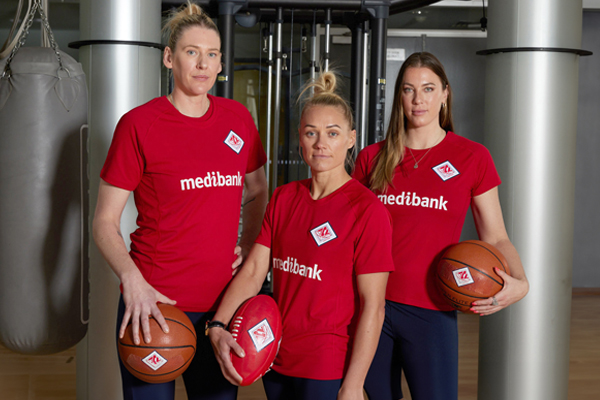-
“How was your day?” It’s a typical question that you might automatically answer with a tired sigh of “busy”. Your daily commitments grow as you do, from the ones you’re passionate about, like family, to the less fulfilling (and sometimes dreaded), like sorting and paying bills. As the hours in each day become more and more filled, committing time to fitness can seem out of reach. But planning your workout doesn’t have to mean working out what plans to scrap. If you’re low on time, a fast, efficient exercise routine could be just the thing you need.
Amy Gianotti is a dietitian, fitness coach, personal trainer, yoga teacher and the founder of Eating Fit, a website that promotes wellbeing and healthy eating. She’s no stranger to hearing how hard it is to fit in exercise with a busy lifestyle, and knows that being active is something that many people feel guilty about trying to squeeze in. In her mind, though, a shorter workout session is still a workout — or, as Amy puts it, “Remember, something is better than nothing.”
READ MORE: Kilojoules burned during exercise calculator
New habits and finding your ‘why’
Amy recommends planning out your workout sessions in advance, including any workout partners you have in mind to keep you motivated. “Start with 20 minutes, 3 times a week and simply go for a walk. Put the word out to a few friends about your intention to be more active, your availabilities and some suggestions [for workouts] you have come up with.” And don’t forget to think about, and even write out, your reasons for taking this time to exercise. “When we are clear on our ‘why’, we have a reason to get up that bit earlier or finish work on time so we can get to our training session. If a reason to exercise describes how it makes you feel, then this is a great motivator as it’s something that is guaranteed with each workout.”
High Intensity Interval Training (HIIT)
If you’re wondering whether a fast workout session can still have the physical benefits you’re after, Amy says that it depends on your goals. If you’re training for a marathon, for example, you might need longer training periods, but for a host of other fitness goals, a lightning fast routine can be a great fit. “If you are wanting to improve your cardiovascular health, general fitness, strength, power, speed, agility, flexibility, stability, increase lean muscle mass, decrease body fat or increase metabolic rate, then 20 minutes offers more than sufficient time!” Amy’s advice is to concentrate on the quality of the exercises in your workout, combining the achievability of the shorter time period with higher intensity routines. In fact, Amy recommends High Intensity Interval Training, or HIIT, as the basis for quicker workouts. She says this type of training involves “compound exercises that engage many muscle groups. For example, choosing squats rather than just calf raises.”
READ MORE: Why is high intensity interval training is so good for you
Lightning fast workouts

-
Top tips for a fast routine
To get the most out of your 20 minute workout, Amy has these tips to share:
Create your own strength or cardio circuit.
Combine paired exercises with opposing muscle groups and alternate between them for 10-15 reps, or 30-60 seconds each for 3 rounds (sets). Alternatively, create a large circuit with 5-10 exercise stations and circle around for 2 or 3 laps. By alternating body parts, you will be able to keep the intensity high and rest periods to a minimum, but still allow muscles to recover between sets, allowing you to keep the quality of work high!
Remember your rest periods.
Interval training combines hard efforts with rest and offers a powerful and popular approach to enhancing fitness. Interval training can be applied to virtually any type of cardio exercise. It is crucial to remember that “rest” is just as important as the hard efforts. Without the rests periods, high intensity work cannot be achieved, and it’s reaching these high intensities that is key [to] stimulating favourable adaptations in body results.
Lift Heavy.
If strength is your main priority and time is limited to 20 minutes, choose 1-3 compound exercises with 5-10 reps, 4-5 sets and 1-2 minutes recover in between. You may aim to hit all major muscle groups over the week across 3-4 days.
Working out your workouts
To help get you started with your lightning fast training, Amy advises having fun with the following workouts:
Strength Circuit
- 10 reps x 3 sets alternating within the pair with 30 seconds rest between before moving to the next station
- 1a) Squats, 1b) Push ups
- 2a) Walking Lunges, 2b) Body Row, seated Row or Pull up (or other ‘back’/pulling’ exercise)
- 3a) Side plank hold (each side), 3b) Plank hold (30 seconds)
- Interval Training
- Choose your mode of exercise: run/cycle/row/X-trainer/stair climb/ki/etc
- 2 minute warm up
- 16 x [30 seconds fast, 30 seconds rest]
- 2 minutes cool down
- Stair Challenge
- Climb 1-3 flights of stairs, jog/walk back down, then complete 10 push-ups or burpees
Aim to complete as many rounds as you can in 10 minutes.
Is HIIT right for you?
The health benefits of high intensity interval training are fantastic, however this type of workout is not suitable for everyone, so visit your GP for a check-up before starting any new exercise program. If high intensity interval training is not for you, your GP can guide you on other great forms of exercise that you may like to try instead.
-
Everything you need to know about parkrun
Been wondering what a parkrun looks like? Where do you go? What do you do? How do you sign up? Find out here.
-
Five ways to exercise when on a budget
You don’t need to spend money on gym memberships just to meet your fitness goals. Here are five free ways to stay healthy and active when you’re living on a budget.
-
How parkrun changed my life
Christie Farrow went from being an exercise-phobe to a true blue runner with parkrun.
-
Australia's top female athletes unite on ACL injury
Some of Australia's most talented athletes have joined forces to highlight the unique injury challenges women face.
-
How to create your perfect summer fitness plan
Be inspired by the sunshine and get moving
-
The essential foam rolling routine
Improve posture and flexibility with this essential foam rolling routine. Discover effective stretches to ease muscle tightness and enhance your daily movement.
Things you should know:
-
* Must be 16 years or over to register for Medibank Live Better rewards in the My Medibank app. Some program partners and earning activities require a person to be at least 18 years of age to be eligible to earn and/or redeem a reward. Must be a Medibank member with hospital cover, extras cover, or hospital and extras cover, and be up-to-date with premium payments. Excludes Overseas Student Health Cover (OSHC), Ambulance only cover, ahm covers and other selected covers. Live Better Management Pty Ltd, ACN 003 457 289 has entered into commercial arrangements with Medibank Live Better program partners and may receive commissions. Please choose carefully as rewards will not be amended, cancelled, exchanged or refunded due to change of mind. Points earning activities and rewards are subject to change without prior notice and may be subject to availability. Additional terms and conditions may apply to points earning activities and rewards. See full Medibank Live Better rewards terms.
Apple, the Apple logo, and Apple Pay are trademarks of Apple Inc., registered in the U.S. and other countries and regions. App Store is a service mark of Apple Inc. Google Pay, Google Play and the Google Play logo are trademarks of Google LLC.





